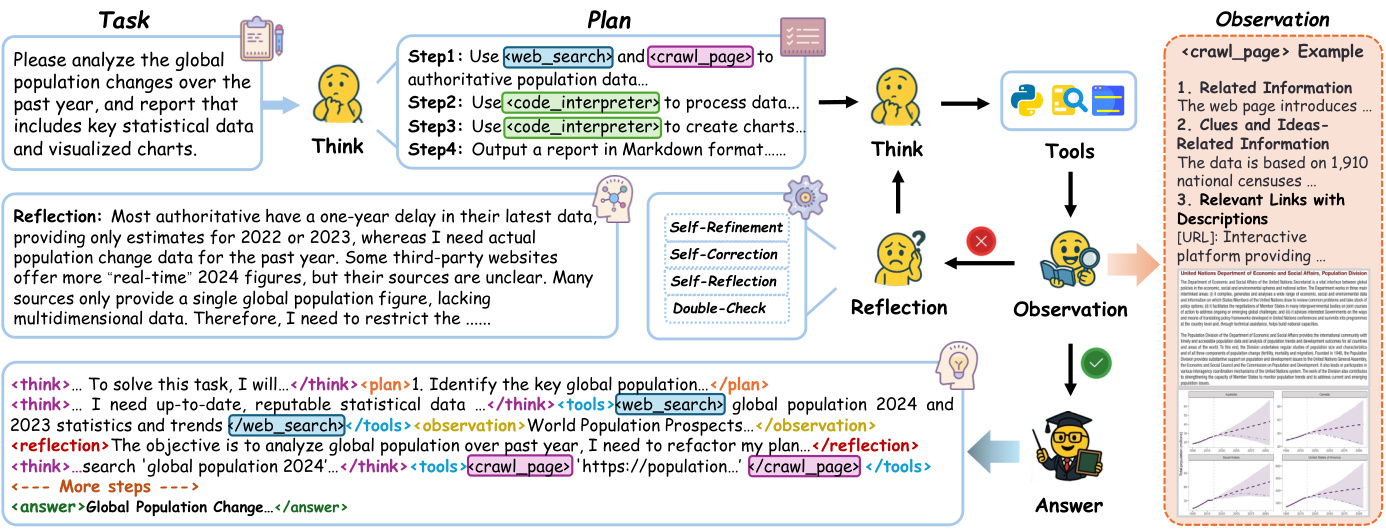Chain-of-Agents: How AI Learned to Work Like a Team

The Evolution of AI Problem-Solving
Remember when Siri could only answer simple questions like “What’s the weather?” Today’s AI systems tackle complex tasks like medical diagnosis, code generation, and strategic planning. But there’s a catch: most AI still works like a solo worker rather than a coordinated team. Let’s explore how researchers at OPPO AI Agent Team are changing this paradigm with Chain-of-Agents (CoA).
Why Traditional AI Systems Struggle
1. The “Lone Wolf” Problem
Most AI systems today use one of two approaches:
-
ReAct-style systems: Follow rigid “think → act → observe” patterns like an assembly line worker. -
Multi-agent systems: Require complex manual coordination between specialized AI “agents” (like hiring different contractors for a project).
Both approaches face critical limitations:
Think of it like comparing a single chef cooking an entire meal versus managing a kitchen with specialized chefs who don’t communicate well.
Introducing Chain-of-Agents: AI Teamwork Made Simple

The OPPO team created CoA to let a single AI model dynamically simulate team collaboration without complex setup. It’s like having a project manager who can instantly assemble the right team members for each task.
Key Components of CoA
This architecture allows the AI to:
-
Decompose complex problems -
Assign tasks to virtual “team members” -
Adapt workflows in real-time -
Learn from experience
How CoA Works: The Training Process
1. Learning from the Best
Researchers used multi-agent distillation to teach CoA:
-
Record how state-of-the-art multi-agent systems solve problems -
Convert these recordings into training examples -
Fine-tune a base AI model using these examples

2. Progressive Quality Filtering
The training data went through four layers of refinement:
This created a dataset of 16,433 high-quality training examples with reasoning chains 5-20 steps long.
Experimental Results: CoA in Action
1. Web Agent Performance
On knowledge-intensive tasks like GAIA and BrowseComp:
2. Code Agent Breakthroughs
For programming tasks:
3. Mathematical Reasoning
On the challenging AIME25 benchmark:
“
“AFM achieves 59.8% solve rate, a 10.5% improvement over previous best methods” [citation:11]
Why CoA Outperforms Traditional Methods
1. Computational Efficiency
Tests on GAIA benchmark showed:

2. Generalization to New Tools
CoA models showed surprising adaptability:
-
Code agents could use web search tools -
Web agents struggled with code formatting
This suggests CoA captures general collaboration patterns rather than task-specific routines.
Test-Time Scaling: The Power of Multiple Attempts
When allowed 3 attempts per question:
This outperforms traditional methods where multiple attempts yield smaller gains.
Practical Implications for SEO and Content
While CoA focuses on AI capabilities, its principles align with modern content strategies:
1. Content Quality Matters
Just as CoA prioritizes high-quality training data, search engines reward comprehensive, accurate content [citation:13]. The 16,433 training examples with 5-20 step reasoning chains mirror how detailed content outperforms shallow articles.
2. Structured Problem Solving
CoA’s planning → execution → reflection cycle resembles effective content strategies:
-
Research phase (identify user intent) -
Content creation (solve the query) -
Optimization phase (update based on performance)
3. Technical Writing Best Practices
The paper’s structure demonstrates technical writing principles [citation:16]:
-
Clear section hierarchy -
Visual aids (figures) -
Performance metrics -
Use cases
Future Directions: What This Means for AI
The open-source release of CoA (model weights, code, and data) creates opportunities for:
-
More efficient AI assistants -
Better reasoning in specialized domains -
Foundation for next-generation agent systems
As AI continues to evolve from “lone workers” to “collaborative teams,” frameworks like CoA will likely become standard for complex applications.
Conclusion
Chain-of-Agents represents a fundamental shift in how we build AI systems. By teaching models to work like coordinated teams rather than rigid pipelines, researchers have achieved state-of-the-art results across multiple domains while improving computational efficiency. As these systems mature, we can expect AI to handle increasingly complex real-world problems with the flexibility and adaptability of human teams.
All images sourced from the original research paper. For complete methodology details and benchmark results, refer to the full paper.

